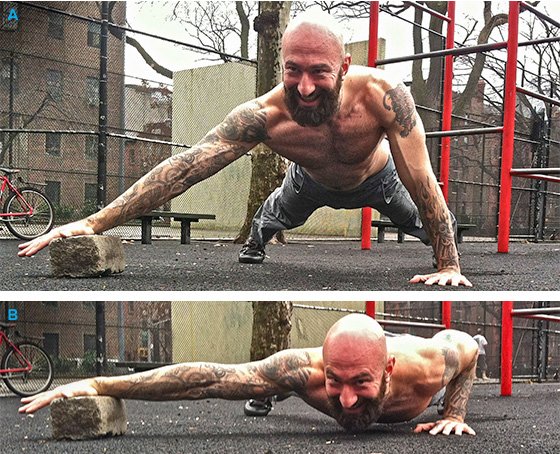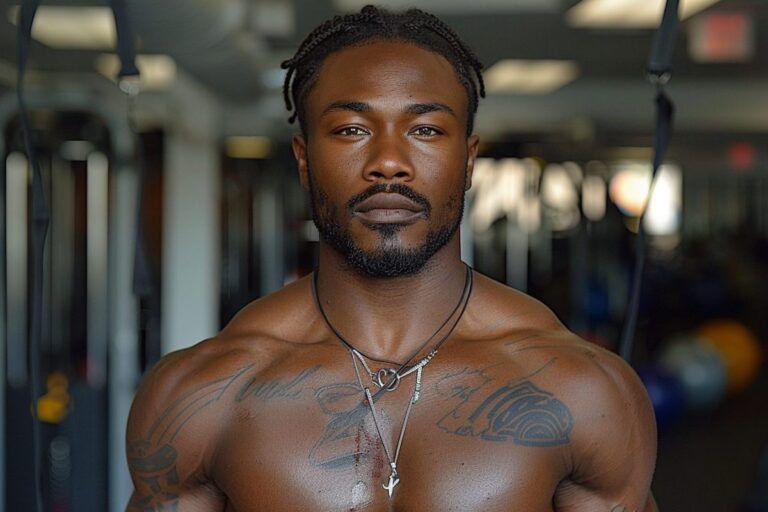Have you ever wondered how long it takes to master the one-arm push-up?
Some bodyweight exercises can be challenging to master.
The one-arm push-up is maybe one of the toughest but one that many people want to conquer.
Let’s look at how long it could take you to learn this impressive move.
How Long Does it Take to Learn One-Arm Push Ups?
When starting, the time it takes to learn one-arm push-ups varies. Some grasp it in weeks, others in years.
For most engaged in bodyweight training, mastering this move typically takes 2-4 months.
Choosing the Correct Variation of One-Arm Push-Up
If you’ve ever watched Sylvester Stallone in the original Rocky movie, you’ll have witnessed a variation of the One-Arm Push-Up.
While Sly showcased strength and flexibility, his technique wasn’t ‘textbook’ one-arm push-up form.
In his training montage, he seemed to perform a variation that blended plyometrics and twisting movements, which, while impressive, deviates from a classic one-arm push-up.
So, What is the Correct One-Arm Push Up Form?
Ideally, a flawless one-arm push-up mimics the standard push-up but on a single arm.
A common mistake is placing the feet too wide apart, which actually makes the move easier.
Some advise keeping the feet together for a true challenge; however, this can lead to body twisting and potential cheating.
When your feet are together this causes the inevitable twist of the upper body and the hips.
So, the side of your body of the supporting arm will be a lot closer to the ground than the other side of the body.
Some people will be able to do one-arm push ups within a couple of weeks by adopting this “twist”, while also having their feet spread wide.
This is commonly seen as a one-arm push-up.
However, I would say this is one of the many progressions towards a perfect one-arm push-up.
So, the feet spread, hip-twisting variety is good, but you’re not quite there yet.
To achieve a perfect one-arm push-up, I recommend shoulder-width foot positioning and a straight body descent, akin to a standard push-up.

Progressing Towards One-Arm Push Ups
Many wonder about the transition from standard to one-arm push-ups.
It’s obviously important to master regular push-ups first, but the shift to one-arm isn’t straightforward.
There’s no direct path from basic to one-arm push-ups; you may excel at regular ones but struggle with the one-arm version.
Strength matters, yet mobility and flexibility are also key.
For instance, focus on wrist flexibility by testing your ability to hold a barbell in certain positions.
Close-grip push-ups are probably the most beneficial groundwork exercise for one-arm push-ups.
You should work towards having your hands closer-and-closer together until eventually your index fingers are touching.
Maintain proper elbow positioning throughout to mimic the hand alignment in one-arm push-ups.
The reason that close-grip push ups are ideal preparation is due to the similar hand position of one-arm push ups.
With one-arm push ups you’ll want your pushing hand directly below the body, as opposed to out to the side.
Training with Incline/Elevated One-Arm Push Ups
Once you can nail 20-30 close-grip push-ups flawlessly, it’s time to level up.
Incline one-arm push-ups on a raised surface help with balance and mobility, requiring less strength per rep.
Always keep your pushing hand higher than your feet to maximize effectiveness.
Start with your hand on a sturdy surface like a window ledge, then progress to a chair or bench for more challenge.
Advancing means lowering the platform height, decreasing body angle, and intensifying the workout.
Basically, the closer your hand is to the ground, the less angle created by your body, and the harder the exercise becomes.
The Technique of Bruce Lee’s Two-Finger One-Arm Push Ups
Progressing Through To One-Arm Push-Ups
Elevated one-arm push-ups can be considered skill work. They focus on balance rather than pure strength.
As your hand moves closer to the ground, strength becomes more crucial.
The key to mastering one-arm push-ups is through self-assisted variations. This will involve having your supporting arm either further ahead or much more out to the side.

Al Kavadlo offers valuable insights and progression methods for mastering this challenging exercise.
Gradually reducing reliance on the assisting arm helps you progress towards performing full one-arm push-ups.
The idea here is to continue working on this technique. At the same time, you learn to rely less and less on the assisting arm.
Eventually, you could have just the fingertips of your assisting arm on the floor, while your supporting arm bears the brunt of the work.







